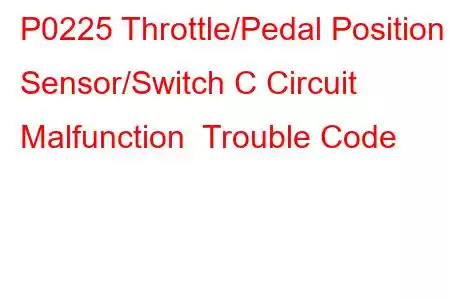P0225 Throttle Position Sensor/Swith C Circuit Malfunction
OBD-II Trouble Code Technical Description
Throttle Position Sensor/Switch (TPS) C Circuit Malfunction
What does that mean?
This diagnostic trouble code (DTC) is a generic powertrain code, which means that it applies to OBD-II equipped vehicles. Although generic, the specific repair steps may vary depending on make/model.
The TPS (Throttle Position Sensor) is a potentiometer that is mounted to the throttle body. It detects the throttle blade angle. As the throttle blade moves, the TPS sends a signal to the PCM (Powertrain Control Module). Usually a three wire sensor: A 5 volt reference from the PCM to the TPS, a ground from the PCM to the TPS, and a signal return from the TPS to the PCM.
The TPS sends the throttle position information back to the PCM on this signal wire. When the throttle is closed the signal is near .45 volts. At WOT (Wide Open Throttle) the TPS signal voltage will approach a full 5 volts. When the PCM sees a voltage that is outside of normal operating range, P0225 will set. The C refers to a particular circuit, sensor, or area of a particular circuit.
NOTE: The PCM knows that any large change in throttle position means a cooresponding change in manifold pressure (MAP). On some models the PCM will monitor MAP and TPS operation for comparison. Meaning that if the PCM sees a large percentage change in throttle position, it expects to see a cooresponding change in manifold pressure and vice versa. If it doesn't see this comparitive change, P0225 may set. This doesn't apply to all models.
Symptoms
Potential symptoms include:
MIL (Malfunction Indicator Lamp) illumination Misfiring at idle or at highway speed Poor idle quality Possibly won't idle Possibly starts and stallsCauses
Potential causes of the P0225 code include:
Sticking throttle return spring MAP or TPS connector corrosion Misrouted harness causing chafing Bad TPS Bad PCMPossible Solutions
If you have access to a scan tool, with KOEO (Key on engine off) observe the TPS voltage. With throttle closed, voltage should be about .45 volts. It should gradually sweep upwards to approximately 4.5 to 5 volts as you depress the throttle. Sometimes only a scope can capture an intermittent glitch in the TPS signal voltage. If you notice a glitch in the TPS sweep voltage, replace the TPS.
NOTE: Some TPS sensors require fine adjustment. If you aren't comfortable with using a DVOM (Digital Volt Ohm meter) to adjust the new TPS, then it's best to take the vehicle to a shop. If the voltage is not .45 volts (+or- .3 volts or so) with the throttle closed or if the reading is "stuck" then unplug the TPS connector. With KOEO check for 5 volts reference voltage present at the connector and a good ground. You can check the signal circuit for continuity by jumping a fused wire between the ground circuit of the TPS connector and the signal circuit. If the TPS reading on the scan tool now reads zero, then replace the TPS. However if that doesn't change the reading to zero, then check for an open or a short on the signal wire and if none is found, suspect a bad PCM. If manipulating the TPS wiring harness causes any change in idle, then suspect bad TPS.
Read: 45


